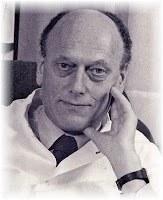
Benjamin Libet is most frequently associated with the Readiness Potential and its implications for free will, but W. Grey Walter (1910-1977), did pioneering work that brought early attention to the phenomenon in Britain and America, although similar findings had been made in Germany and later in Finland.
Born in Kansas City, Missouri, he lived in England from the age of five, and became interested in neurophysiology at King's College, Cambridge.
 |
| W. Grey Walter |
W. Grey Walter was a pioneer in the field of cybernetics. Between 1948 and 1949. he devised autonomous machines, robots Elmer and Elsie, that mimicked human behavior, which paved the way for popularization of cybernetic theory. Claiming his self-help teachings as founded on cybernetics principles, Maxwell Maltz, MD, a cosmetic surgeon, sold many books on Psycho-Cybernetics, essentially advising how the mind can be programmed. (A Biblical phrase puts it tersely, although with other intentions: As a man thinketh, so is he.)
By using Elmer and Elsie, W. Grey Walter established that consciousness complexity can arise out of simplicity in the brain--that a small number of brain cells can give rise to very complex behaviors. This, he felt, would establish that human consciousness is not immeasurably complex and can be studied by scientific means. By doing so, he wanted to demonstrate that human brain hard wiring could provide researchers with understanding of consciousness operations. Called tortoises because of their slow pace on three wheels, Elmer and Elsie provided models to understand brain organization. Capable of photo taxis (movement toward a light source), they could maneuver to a stationed battery charger when running low on power.
He conducted a "self-awareness test" on one robot by placing a light on the "nose" of a tortoise while he watched as the machine observed itself in a mirror. "It began flickering, twittering, and jigging like a clumsy Narcissus", he wrote. He held that this "might be accepted as evidence of some degree of self-awareness" if observed in an animal.
 |
| Hans Berger |
His work with EEG electronics led him in WW2 to help develop radar technology. In Winston Churchill's history of the Second World War, the former Prime Minister wrote about the debt Britain owed to the developers of radar, a system that was a key tool in scrambling RAF Spitfires aloft to intercept Luftwaffe bombers steady-on for England. Walter was one of those developers.
 |
| Benjamin Libet |
It suggests that free agency is an illusion and that we assume we choose when in fact we don't. Instead, we are creatures of cause and effect, determined by stimuli and forces in the environment.
The basic findings have been repeated by various experimenters as the concept is straightforward and its
 |
| Hans Kornhuber |
Nor can their implications for consciousness and free agency be lightly dismissed, given the consistency in the experiments--that the decision to act follows the action. In effect, the observer can predict what the subject will do before the subject knows his own response.
 |
| Lüder Deeke |
Articles on Benjamin Libet can be found , Libet and Free Won't, 15 March 2004, The Illusion of Free Will, 28 December 2003 & at the link devoted to free will, found at the top of the home page.

